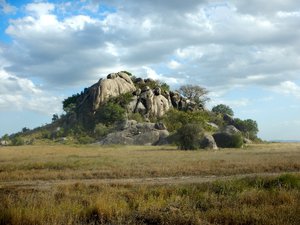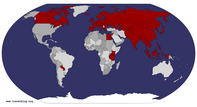Advertisement
Published: August 14th 2014

 Pride Rock in the Serengeti
Pride Rock in the Serengeti
There was a herd of elephants hanging around the rock.Total Distance Travelled Today: 292 km
Elapsed Travel Time: 11 hours 11 min (including game drive)
Lodging for the Night: Dik-Dik Campsite
Our first night camping in Africa was not bad at all. Unfortunately we both awoke at 3 am and were not able to get back to sleep - a bad case of jetlag as a result of sleeping during the day on our first day. It was okay because breakfast was at 7 so we only had 3 hours to wait for our 6 am alarm to go off.
After breakfast we had to repack some of our gear into one bag, and we transferred some of our things from our large gadventures truck into two smaller safari jeeps that we're going to use for the next 3 days. There was 6 of us in total in the jeep; Anna (Kiwi), Matt (Kiwi), Sarah (Kiwi), Holland (US) and us. We called ourselves "Team Poa", a word that means cool in Swahili. In these jeeps, we travelled from Arusha through the western border of the Great Rift Valley towards the Ngorongo crater and the famous Serengeti. The drive to the crater took us through the Tanzanian countryside for
about 4 hours. On our way we caught a glimpse of a few wild giraffes by the side of the road. It was breathtaking to see this African animal that we normally only see in the zoo, in the wild! This was our first glimpse of the exotic african animals, and it such an amazing feeling that also makes you feel so very far from home. You certainly don't see a giraffe walking around in Canada! We got out of the jeep and walked into the bush a few metres to get a closer view of the giraffe. It's especially amazing to see them in a place where you are not expecting them!
On our way up to the crater, we also saw some baboons! Our jeep climbed up 2400m to the rim of the crater and had an amazing view of all the vegetation and animals on the inside. Although the size of ants, we could make out the images of buffalo and elephants, grazing around on the grass. We were told that there are no giraffes because they can't climb the crater's walls. The crater was formed by an ancient volcano, but we will write more about
that in a few days when we come back to explore the crater further! The walls of the crater go up 400m and the diameter is 11 km in one direction and 21 km in another.
We had a wonderful prepackaged lunch along the rim of the crater and got to take in more of the views. After lunch we drove along the rim of the crater and descended down towards the plaines of the Serengeti. We will head back to the crater in a few days.
The Ngorongo crater is a conservation area, not a national park. The distinction enables the Masai tribe to use the crater as their lands for keeping their livestock. They do not hunt or eat game meat (they only eat blood, milk, and their own livestock meat) so the other wild animals are not endanger of being eaten by them, so they have special permission to live there. Therefore, until we exited into the Serengeti, we saw a lot of Masai people and their cows and goats by the side of the road (Mike often mistook them for buffalo). Once in the Serengeti, you don't see them any longer. It also means
that you no longer get hassled by the Masai children, who are always looking for money in exchange for photos or for nothing. We've been to worse places for being hassled, so this doesn't really bother us.
Once we passed into the Serengeti, we began a game drive along the long grass plains. We saw lions with baby cubs, tons of zebras, wildebeests, elephants, hyenas and gazelles (including Thomson's and Grants, as well as other antelope like impalas), cape buffalo, baboons, jackals, ostriches and other birds (like the secretary bird and the bustard) and lizards. The drivers of the different vehicles that were around often stopped to tell each other about the wildlife they have seen, that way everyone knows about the interesting animals around. Also, often our guide would get a call over the radio about some interesting animal or situation, and we would drive to that spot to see what was going on. Fortunately for us, there weren't actually that many cars around, so we felt less like tourists. We drove around the Serengeti with the top popped open so we could stand up and see better. We were looking for the "big 5" (elephants, lions, buffalo,
leopards and rhinos), and unfortunately were only able to see the first 3 today. Hopefully in the next couple of days we will get to see more, although we've heard that the Leopard is quite elusive and hard to find. We were really lucky with our timing in the Serengeti. When we had booked this trip, we found out that we were very luckily going during the time of the great migration, when herds of animals (ex. Wildebeests and zebra) migrate north towards more rainy areas. We thought that since we were going South, that it was probably a better chance of crossing paths with the migrating animals. However, the migration North had already occurred this year, but the animals had come back early to the Serengeti because there was more rain than usual. So in the end, we ended up being really lucky to actually get to see parts of the great migration, and there were tons of huge herds of these animals all running around together. It was very cool to see so many animals (looks like so much organization). One of the Japanese girls, Mayumi, had done the balloon flight over the Serengeti, and she had some
amazing views of the migrating animals from above. We wished we had splurged the money on that as well.
Lion cubs following their mom
Sights from our day on the Serengeti
After a few hours driving around the Serengeti, we headed to the campsite, which was called Dik-Dik Campsite. The campsite itself was out in the wild in the middle of the Serengeti, with no fence between you and the animals. This makes for a real interesting wildlife experience. We weren't exactly roughing it though. Although there was no electricity at all in the campsite, we did have shower and toilet facilities (but only cold water for showers!).
For the next two nights, our accommodation is what they call "full service camping". This means that instead of having to set up our own campsite, the tents had already been set up for us. Additionally, we had cooks that set up, served dinner and cleaned up after us. This is a nice change (although this is only out second night!). We put our bags into our tents and went to the dining hall for dinner. By now it was getting dark and cool out. We
were served a yummy dinner of vegetable soup, beef stew and rice with veggies and cake for desert. Not really sure how local this dish is ( this is the problem with a camping tour that includes food- you're a bit detached from the local dishes that you can choose for yourself if you go out to eat), but after a long day out, it was yummy.
After dinner, they lit a fire for us, but we didn't sit around it for too long. In the dark, one of our fellow campers, Brandon, spotted a snake near the fire. He pointed it out, and Masivu (our guide) was pretty scared of it (we gave him the name of our fearful leader from this), but the snake just went away. It turned out that the snake was actually a very poisonous snake called the Black Mamba. Neither of us were close to the snake, and Elysia was very glad she didn't know about it until much later! It was dark and we were all tired so we pretty much went straight to bed at 9. We were all very worried about having to get up in the middle of the
night to pee, because the bathrooms were far away and there was many possibilities of running into wild African animals. The protocol was that if you had to pee, you either pee right next to your tent or take your buddy to the washroom with you, because the animals generally stay away from humans if they're not alone. Fortunately neither of us we had to leave our tent until the next morning. This was fortunate because in the middle of the night, we heard some lions growling from a spot very close to our tents. Also, the cool thing about not having a fence surrounding the campsite, is that at least one elephant during the night was eating grass from the side of our tent, and then it walked between our tent and our neighbours' tent. It was really fun though to hear the sounds of Africa right outside our door, and be a part of the landscape!
Advertisement
Tot: 0.055s; Tpl: 0.013s; cc: 12; qc: 21; dbt: 0.0274s; 1; m:domysql w:travelblog (10.17.0.13); sld: 1;
; mem: 1.1mb























